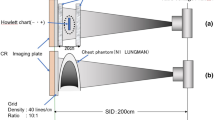Abstract
We propose determining the entrance surface air kerma (ESAK) from the kerma area product (PKA) in digital radiology. ESAK values were derived from the X-ray tube outputs and patient exposure factors across five X-ray departments. Using linear regression between ESAK and PKA values, the slope and intercept coefficients were determined for each X-ray equipment and procedure. The method was examined using the data collected from patients who underwent chest PA/LAT, abdomen, pelvic AP, and lumbar spine AP/LAT X-ray examinations. The results showed a highly significant correlation between ESAK and PKA values and correlation coefficients, ranging from 0.77 to 1 with P-value < 0.001 in most studies. This method can be employed by incorporating dose data and related parameters into the X-ray device’s software, similar to other dose-displayed information. The online determination of ESAK from PKA could help with quality assurance and patient dose management in digital radiology.





Similar content being viewed by others
References
IAEA (2007) Dosimetry in diagnostic radiology: an international code of practice. International Atomic Energy Agency, TRS No. 457, Vienna, Austria
ICRU (2005) International Commission on Radiation Units and Measurements (ICRU). Patient dosimetry for X-rays used in medical imaging. J. ICRU 5(2)
Al-Jabri AJ, Alzimami K, Alsafi K, Alaamer AS, Al-Rajhi MA, Suliman II (2019) Retrospective analysis of patient radiation doses in digital coronary angiography and interventions. Radiat Prot Dosim 183(4):497–502
Suliman II (2020) Estimates of patient radiation doses in digital radiography using DICOM information at a large teaching hospital in Oman. J Digit Imaging 33(1):64–70
Mattar E, Alsafi K, Sulieman A, Suliman II (2019) Occupational exposure of the operator eye lens in digital coronary angiography and interventions. Radiat Phys Chem 165:108400
McParland BJ (1998) Entrance skin dose estimates derived from dose-area product measurements in interventional radiological procedures. Brit J Radiol 71(852):1288–1295
Kisielewicz K, Truszkiewicz A, Wach S, Wasilewska–Radwańska M (2011) Evaluation of dose area product vs. patient dose in diagnostic X-ray units. Phys Med 27(2):117–120
Suliman II, Sulieman A, Mattar E (2021) Radiation Protection Evaluations Following the Installations of Two Cardiovascular Digital X-ray Fluoroscopy Systems. Appl Sci 11(20):9749
Lin PJ, Schueler BA, Balter S, Strauss KJ, Wunderle KA, LaFrance MT, Kim DS, Behrman RH, Shepard SJ, Bercha IH (2015) Accuracy and calibration of integrated radiation output indicators in diagnostic radiology: a report of the AAPM Imaging Physics Committee Task Group 190. Med Phys 42(12):6815–6829
Parry RA, Sharon AG, Benjamin RA (1999) Typical patient dose in diagnostic radiology: the AAPM/RSNA physics tutorials for residents. Radiographic 19:1289–1302
Dickinson RL, Zamora DA, Kanal KM, Stewart BK (2014) Estimated skin dose look-up tables and their effect on dose awareness in the fluoroscopy-guided imaging suite. Am J Roentgenol 203(3):630–636
Dietrich TJ, Pfirrmann CW, Schwab A, Pankalla K, Buck FM (2013) Comparison of radiation dose, workflow, patient comfort, and financial break-even of standard digital radiography and a novel biplanar low-dose X-ray system for upright full-length lower limb and whole spine radiography. Skeletal Radiol 42(7):959–967
Mora P, Pfeiffer D, Zhang G, Bosmans H, Delis H, Razi Z, Arreola M, Tsapaki V (2021) The IAEA remote and automated quality control methodology for radiography and mammography. J Appl Clin Medical Phys 22(11):126–142
International Commission on Radiological Protection (ICRP) (2004) : Managing patient dose in digital radiology. ICRP publication 93. Ann ICRP 34:1– 74
Funding
The authors extend their appreciation to the Deanship of Scientific Research at Imam Mohammad Ibn Saud Islamic University for funding this work through research group No. RG-21-09-45.
Author information
Authors and Affiliations
Corresponding author
Ethics declarations
Conflict of interest
The author has no conflict of interest to declare.
Ethics approval
The study included retrospective data and informed consent was not required.
Additional information
Publisher’s Note
Springer Nature remains neutral with regard to jurisdictional claims in published maps and institutional affiliations.
Rights and permissions
Springer Nature or its licensor holds exclusive rights to this article under a publishing agreement with the author(s) or other rightsholder(s); author self-archiving of the accepted manuscript version of this article is solely governed by the terms of such publishing agreement and applicable law.
About this article
Cite this article
Suliman, I.I. An approach for the online determination of Entrance Surface Air Kerma (ESAK) from Kerma Area product (PKA) in digital radiology. Phys Eng Sci Med 45, 1055–1061 (2022). https://doi.org/10.1007/s13246-022-01167-7
Received:
Accepted:
Published:
Issue Date:
DOI: https://doi.org/10.1007/s13246-022-01167-7




